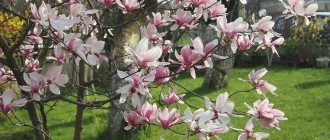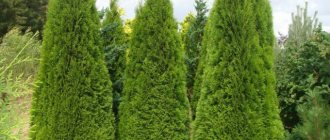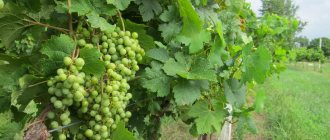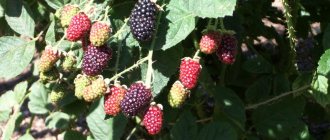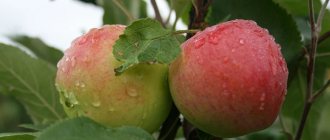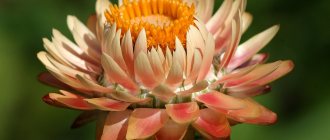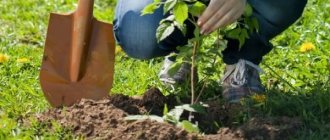Caring for thuja after planting
One- or two-year-old thujas can be planted in spring or autumn.
After planting, thuja seedlings need time to take root in a new place and begin to grow. All conditions are created for successful development: systematic watering is arranged, the soil is cultivated, and fertilizing is applied. Speaking of fertilizing: the first year of life, thuja can grow without additional fertilizers. What is enough for her is what was added to the soil when the site was planted. After planting, you can only stimulate the healthy development of the plant, for example, add the Epin stimulant or use a Zircon solution. These preparations help protect young plantings from pests and diseases and will help improve the absorption of nutrition from the soil.
It is important to saturate the roots of the tree with moisture. Although thuja loves water, it does not tolerate stagnant water, so it is planted in areas with low groundwater, but in the meantime it is watered infrequently and abundantly
Lack of moisture immediately affects the appearance of the plant - the apical part begins to turn yellow and wither. With regular watering this problem can be avoided. The first month after planting, plants need a lot of moisture more than ever. Conifers are watered once every 6-7 days in moderate weather and 2 times a week in drought, using 2-3 buckets for each plant. During humid summers, thujas are not watered - natural precipitation is enough for them. When watering thuja, you need to use the sprinkling method - this way the juiciness and freshness of the leaves will be even stronger, the pine aroma will become brighter, and the branches will be cleared of dust and shine. Water the crop in the early morning or late afternoon.
Please note: the soil will settle after planting, so it needs to be replenished.
The root area must be kept free of weeds. Loosening can cope with the ubiquitous weed, which also promotes good soil aeration. To curb moisture evaporation, experts recommend mulching plantings. Either sawdust or compost are suitable as mulch. Such a shelter does not allow weeds to grow, and by overheating, it also nourishes the soil with nutritious juices. The roots under the mulch are reliably protected from the scorching summer sun. As a result, the tree feels better and turns greener every day.
Attention: the roots of the thuja are located close to the surface of the earth, and therefore the loosening should not be deep, no more than 10 centimeters.
For the first two years, the thuja looks at a new place of residence and takes root. At this time, cutting should be delayed until the tree reaches the desired size and has acquired a sufficient green head.
Subsequently, every spring work to care for the crop will be supplemented with sanitary and formative pruning. Initially, it is necessary to remove all broken, old and damaged branches - this is done in April. Then the bush is thinned out, removing unnecessary shoots from the plant, as well as annual growths. Depending on the variety, a shaping haircut is performed. Almost any shape can be formed from thuja, and it will become the main element of garden design.
How to plant thuja in open ground correctly
When is the best time to plant thuja? Planting a bare-rooted seedling is best done in early spring or fall (maximum 6 weeks before the first frost), then the plant can best adapt to its new location.
However, in nurseries, seedlings are sold mainly in containers, which allows them to be planted throughout the growing season. The planting conditions for thuja are similar to other representatives of conifers. First of all, they start with choosing a location and preparing the substrate.
What kind of soil is needed for thuja? It is believed that the plant is not too demanding on the composition of the soil, but the tree grows best on permeable and fertile soil, moist and rich in nutrients with a slightly acidic reaction.
Spring planting of trees and shrubs
Thuja, planted in too dry and poor soil, reacts with loss of color, darkening and sometimes intense loss of scales or exposure of the lower branches. Such weakened plants are easily infected with a fungus that causes the shoots to die.
Choose a place for growing that is sunny or lightly shaded, protected from the wind, which in winter can cause young shoots to freeze. Thuja varieties from the Golden or Variegata series show bright color only in well-lit areas.
Important! On lawns, thuja branches should not touch the grass, since the lower leaves often become wet due to dew, which leads to the development of fungal diseases
The soil must first be thoroughly cleared of weeds, which draw nutrients from the soil and weaken the seedling.
The planting hole should be 2 times larger than the root ball. A layer of crushed stone or broken brick is poured at the bottom of the hole for drainage, then a layer of garden soil mixed with dry pine needles or high-moor peat is poured.
Planting a seedling
Another valuable component that increases the nutritional value of the soil is compost, to which trees respond very well. Compost can be replaced with granulated manure or watered with diluted vermicompost after planting.
It is very useful to add mycorrhiza (fungal mycelium) to the soil, which enters into symbiosis with the roots, making it easier for the plant to absorb nutrients and water.
Mycorrhizal fungi improve plant growth and make them more resilient to environmental stress, including drought and pathogens.
The plant is removed from the container with a lump of earth and placed in the planting hole. Cover with soil, tamp down so that the soil does not sag and water abundantly.
Watering thuja after planting
Seedlings are planted at a distance of at least 50 centimeters from other plantings so that they do not compete with each other and good air circulation is maintained.
How to plant thuja for a hedge? It is best to plant in early autumn at a minimum distance of 50-70 cm from a fence or other buildings. The spacing between plants will depend on the crown size of each variety.
Planting for hedges
For the popular varieties “Smaragd” or “Brabant”, a distance of 70-90 cm will be sufficient. Narrow columnar varieties such as “Holmstrup” are planted at a distance of 50-60 cm from each other.
Basic rules of care
Rules for planting and caring for hydrangea in a summer cottage
Usually, for any unpretentious indoor plant, the care rules are quite simple. For better orientation, we have placed them in a table:
| Options | Description |
| Lighting | diffused light, does not tolerate direct rays, shading is necessary in spring and summer |
| Temperature | the optimal temperature is 10-15 ˚С, in summer you need to keep it cool, you can place it in fresh air, for example, on an open balcony |
| Air humidity | resistant to dry air, but will grow better in moderate humidity; in summer, care comes down to periodic spraying |
| Watering | moderate and regular watering, avoid waterlogging and drying out, requires fertilizing with mineral fertilizers in half the dosage |
| Earth | 4 parts of leaf and 2 – coniferous soil with one part of sand for young sprouts and 1 part of peat and the same amount of turf soil with ½ part of sand for mature trees, requires well-arranged drainage |
| Accommodation | north or west window, shaded cool place, open air in summer, placed in deep oblong pots or in a tub |
| Reproduction | cuttings in July - August, sowing in early spring with seeds ripened in September - August (preferable for domestic conifers due to rapid growth, but you will have to carefully care for them) |
Watering and fertilizing
Common privet planting, methods of propagation and simple rules of care
Planting and caring for thuja in the garden will not take the gardener much time. Growing this plant involves following only a few manipulations:
- organization of watering;
- fertilization;
- loosening the soil;
- performing pruning.
When talking about how to plant and care for thuja, it is worth considering the fact that this culture is moisture-loving.
In the spring, it is enough to water it once a week, but you should take the weather into account. During watering, about 1 bucket of water is poured under each young specimen.
But if it rains frequently, then this may not be necessary.
With the arrival of summer, the frequency of watering increases, so it is necessary to water the plants every three days. If the weather is too hot, watering is carried out every 2 days. In the summer, one such procedure requires 1.5-2 buckets of liquid.
Both seedlings and adult specimens are equally moisture-loving. As the tree grows, the amount of water should increase. It is recommended to water the plants alternately with crown irrigation. In this case, the branches will become more elastic, and the foliage will always be juicy and bright. During irrigation, all dust from the branches is washed away, and the tree takes on a more well-groomed and fresh appearance. It is recommended to carry out such manipulations 2 times a day: morning and evening.
The appearance of the needles can indicate an insufficient amount of moisture. If the top turns yellow, this indicates that it is necessary to take measures to moisten the soil.
As for fertilizing, the first one is carried out immediately after planting the thuja in open ground. For this, a solution of a growth stimulator is used. The elements that make up it help the plant quickly take root and settle into a new place. Adult specimens require additional phosphorus and potassium in the spring. Compositions containing them should be applied twice, with a break of two weeks.
Both mineral and organic fertilizers are suitable as fertilizing. To do this, you can purchase special formulations in a specialized store that are intended for conifers, for example, Fertik. Simple compost is also suitable for these purposes. Fertilizers are applied twice a year: in spring and summer. In this case, the soil should be sealed around the tree trunk by loosening. In summer, it is allowed to water the trees with a fertilizer solution.
Features of care
For the full growth of thuja, regular watering of the soil is necessary, especially by rain. If you stop caring for thujas, they become dull, sparse, with a large number of cones and lose their original attractiveness. You should not get too carried away with fertilizing the plantings, as they begin to grow quickly, at the same time losing their original shape and special charm of beauty.
It is better to form the crown in the spring, removing damaged, dry and simply unnecessary branches. Thuja is one of those trees that have a compact root system and can easily transfer the process of replanting to another place. In the fall, in the process of preparing trees for winter, it is recommended to carefully cover and tie the thujas. This will allow you to preserve the decorative beauty of the crown for longer, and will also protect them from the burn of ultraviolet radiation from the sun. Trees and bushes can easily tolerate pruning, provided that it is done as carefully as possible.
Soil fertilization is carried out according to the following rules:
- at the very beginning of spring (even if there is snow), the area is treated with complex fertilizers with a predominant nitrogen content;
- with the onset of June, potassium microelements must be added to the soil;
- if the soil is too poor in nutrients, then you should not refuse the opportunity to fertilize it with special phosphorus complexes.
As protection against pests, trees are recommended to be treated with Actellik or Karbofos. Prevention itself should be carried out in early spring (even before the buds open), at the beginning of summer, and also in the second ten days of July. The last treatment is carried out in the fall, in the process of preparing the thuja for the winter cold.
If trees were planted in spring or summer, they should be watered generously once a week. In this case, the weather should be warm. With the onset of prolonged summer heat, it is important to double the frequency of soil irrigation. Moreover, under normal weather conditions, at least one bucket of water should be poured under each tree or bush. In extreme heat, watering should consist of buckets under each plant. It is important to carry out the procedure itself early in the morning or late in the evening, after sunset.
It is extremely important to monitor the level of soil moisture, since excess moisture observed within two weeks can damage the root system and have a detrimental effect on the bushes and trees themselves.
Pruning and mulching
Features of caring for chamelacium at home
Caring for thuja also involves removing weeds, regular mulching and loosening the soil. Any organic materials can be used as mulch:
- compost;
- straw;
- sawdust;
- small nut shells.
Such mulch can stop the growth of weeds and also retains moisture in the soil, thereby improving plant development. A layer of mulch is also often used for decorative purposes, using, for example, colored sawdust. To make the conifer look more attractive, its crown must be trimmed periodically.
Only specimens that have already taken root well in the open ground are trimmed, and at least two seasons have passed since their planting. For the first time, thujas are pruned for sanitary purposes. In this case, all damaged, dry, weakened and diseased branches are removed. The more often this pruning is carried out, the more magnificent the bush becomes.
The main pruning is carried out in the spring, preferably in April, in dry weather. Throughout the season, if desired, corrective trimming of the tree is carried out. During this, the length of the branches is shortened by no more than 1/3. In order for the plant to feel good, it is necessary to leave a distance between the branches so that air can circulate freely there. To do this, all shoots of annual growth are removed.
By cutting a thuja, you can give it the shape of a cube, a ball, a column, a step - it depends only on your imagination. In European countries, you can often find various fabulous animals made from conifers in city parks.
Diseases and pests of thuja
Pests that most often bother thuja:
- Aphid;
- Shchitovka;
- Luboed;
- Gypsy woody plant.
Because of aphids, the plant can turn yellow very quickly. You can get rid of it with the help of decis. Simply spray the plant with it.
Scale insects harm not only the needles, but also the cones. The pine beetle has a detrimental effect on wood, forming tunnels in the bark. Woodwort can be identified by round holes in the bark of the plant. The walls of the holes are usually black. Pest control measures include spraying with insecticides. It is advisable to do this at an early stage of the lesion.
At home, thuja can become infected with fungus. This disease affects the crown of the plant. To fight at the initial stage, you should use karbofos. Treat the thuja several times until it recovers.
Of course, an outdoor plant is much more susceptible to disease, but you should also keep an eye on your indoor thuja.
In general, caring for thuja at home is simple and elementary. Therefore, this plant is suitable for those who do not want to spend too much time on cultivation.
Watering and autumn feeding of thuja
Regular watering should be provided to thuja, which grows in a region characterized by dry autumn. Before the onset of frost, watering should be especially abundant (moisture-charging watering): the roots will be saturated with moisture for a long time, the wet earthen ball will freeze longer, which will protect the rhizome from sub-zero temperatures, as a result, the thuja will be more resistant to changes in temperature conditions in winter. If it is autumn, with a lot of rain, the coniferous tree is practically not watered additionally (except for the final moisture-recharging watering).
Top dressing
For better wintering, it would not be a bad idea to apply autumn fertilizer to the thuja, although if in the spring you already gave a complex long-acting fertilizer, then there is no need to additionally feed it.
Thuja care at home
Thuja is grown both as a house plant and as an outdoor plant. Let's talk about the first type first. Thuja orientalis is grown at home.
Thuja: care
- Lighting is preferable to diffused light or partial shade; protect thuja from direct sunlight. It is better to place the plant on windows on the north side; create shading in spring and summer.
- The temperature is room temperature, in winter - 6-12°C. In summer, thuja can be taken outside, but to a cool place.
- Watering in summer is abundant, in winter – moderate and only after the top layer has dried after the last watering. But the soil for thuja should always be moist. Watering is moderate but regular.
- Thuja requires high humidity, so in winter, when heating is active, the plant must be sprayed.
- Replant for young thuja - once a year, for an adult - once every two to three years. Also prepare good drainage. To transplant young thujas, use the following mixture: 2 parts coniferous soil, 4 parts leaf soil, 1 part sand. For transplanting adult thujas: 1 part turf soil, 1 part peat, ½ part sand.
- Feeding: fertilizers should be used in the period May-September; once every three weeks, feed the thuja with fertilizers for coniferous plants.
- Reproduction is carried out by seeds, cuttings and layering. The seeds must first be soaked in water or stratified for 12 hours until they sprout.
- Thuja dormancy occurs between October and February.
If you do everything correctly, then your home will be decorated with thuja domestica; caring for it will not require much effort and time, the main thing is to comply with the necessary standards and deadlines.
Thuja occidentalis: care
Plant in partial shade, in a place protected from the wind. The best soil for the plant is fertile, moist, loamy.
It is important to avoid insufficient moisture and over-hydration. In the case of close contact with groundwater, before planting, drainage should be made from 20 cm of crushed stone. In the first month after planting, abundant, weekly watering and irrigation of the plant crown are necessary
Abundant watering is also needed in dry times, for young thujas - twice a week, 1.5-2 buckets per plant. After watering, shallow loosening and mulching with peat, humus or wood chips would also be useful. Top dressing: during the spring-early summer period, organic and mineral (ash, saltpeter) fertilizers should be applied to the root zone. Seasonal care: in the spring you can form a crown, clean the plant from dry twigs and replant; In winter, you can cover the thuja with burlap from winds and frosts. Reproduction is carried out by cuttings, which are treated with heteroauxin and placed in a greenhouse.
How to water thuja in summer
How often to water roses
After planting in the spring, in the first month you need to irrigate once a week, always spraying the crown with a hose (but without strong pressure). Thanks to sprinkling, dust is washed off the tree, the stomata of the leaves open, all the vital processes of the plant proceed with renewed vigor, and it takes root better. This irrigation is carried out for 20 minutes. for every tree. The air temperature should be no more than 25°C. Also, after such a bath, the pine aroma intensifies.
Important! On hot, sultry days, it is better to irrigate daily early in the morning before the sun shines or in the evening, after the heat has subsided a little.
When planting in autumn, thuja also requires abundant watering. In this way, the plant accumulates enough vitality to survive the cold winter. If it rains in the fall, you should stop watering. If the soil under the thuja becomes waterlogged within a half-month, it may get sick.
How often to water thuja in summer: how many times
In the heat, abundant evaporation occurs, and all plants need more moisture, including this coniferous beauty. On such days it is worth watering every other day and very generously. If the weather is damp, then watering is reduced to once a week, and if the weather is changeable, not hot, but without rain, the procedure is carried out twice a week.
In the fall, you also can’t leave irrigation of the roots to chance. Even if it’s not hot outside, the roots still need moisture and watering should be continued until frost sets in. The plant should go into winter with moist roots.
Watering thuja
Growing methods
There are only three of them:
- seeds
- cuttings
- seedlings
The first method of planting, seeds, is not particularly popular. In itself, it represents a rather lengthy process, yielding a result in the form of a good seedling no earlier than after five years. And it’s not a fact that a varietal tree will grow from a seed. But there is also a positive point - such seedlings will adapt perfectly to any environmental conditions.
Fresh seeds are best for this method, but it is recommended to leave them under snow cover before planting. After such measures, their germination will be much more effective. In spring, it is recommended to place the seeds in nutritious soil, water them, and sprinkle them with a thin layer of soil from softwood sawdust. Shoots will appear quite quickly, but you will need to carefully care for them.
After three years, the plants will gain stamina, and in the fifth season they can be transplanted into open ground. The cutting method is more effective and gives better results. It is with its help that the best results in obtaining varietal trees are achieved. To do this, in the spring, young shoots no older than three years are taken and separated, leaving a piece of wood. The process is best done early in the morning or on a cloudy day. It is advisable to take shoots from the upper parts of the plant. This preserves a high probability of inheriting the characteristics of the parent specimen.
The cutting should be soaked in potassium permanganate to disinfect it. A good solution would be to use growth stimulants. After this, the cutting is transplanted into the ground at an angle, shaded and watered abundantly. This is best done in a special greenhouse. By the autumn season, the cuttings should have taken root. The plants are covered for the winter and replanted in the spring.
The easiest way is to purchase a ready-made seedling. It is reliable, but quite expensive. But at the same time, the purchase should be made in a specialized nursery in order to purchase a high-quality sprout that is resistant to climate and various diseases.
Rules of care
Newly planted thuja trees require regular watering. Minimum one bucket per week, more in hot weather. Yes, and adult plants need a sufficient amount of moisture. Otherwise, their tops will begin to turn yellow. Another negative manifestation is the appearance of cones that spoil the appearance of the tree.
It is best to water in the morning or evening. Don’t forget about another type of care – sprinkling. After this process, the needles become clean and look fresh, emitting a great smell. There should be no weeds around the tree; the soil must be loosened. You can mulch these areas.
To ensure winter resistance, thuja trees should be fed. But this should not be done often; it is enough to perform the event once per season. It is recommended to use compost and specialized fertilizers for conifers.
After two years of growth, the tree can be pruned, giving it the desired decorative shape. It is best to use a powerful pruner for this so as not to crush the tree branches! The tree should be trimmed twice - in summer and autumn, removing all dry branches. You should know that thuja is considered a hardy tree and grows everywhere. But its location affects the appearance of the plant. It is best to use shady areas protected from the wind.
Purchase of seedlings
Specialized garden stores and nurseries currently offer gardeners a huge selection of thuja seedlings of various varieties. You can choose trees of absolutely any age and size. It is best, of course, to buy small specimens and then plant them in the countryside for growing. In most cases, there are no problems with this.
Planting young seedlings is preferable for the reason that they take root much faster in a new place, unlike mature trees. If a gardener wants to decorate his summer cottage as soon as possible, he will have to purchase an already mature, developed plant.
When purchasing, you need to carefully inspect the thuja, paying special attention to the following factors:
- How wet is the soil in the container with the seedling.
- How tightly do the scales stick to the branches?
If the seedling is of good quality, then its branches will be strong, elastic, without any spots or signs of damage by parasites or diseases. Under no circumstances should needles fall off from young bushes. Having purchased a thuja from a nursery or store, it must be planted in the ground and watered as soon as possible.
Thuja - planting and care
1.1.Keeping at home, pruning
Periodically trim off old dead branches that appear at the base of the plants. Use pruning to form trees into the desired shape and size, but do not remove too many branches at once. Formative pruning is carried out in the spring. Some varieties maintain an attractive compact shape on their own and do not require pruning. In the warm season, it is advisable to take the plants out into the fresh air, where they will feel much more comfortable than indoors.
1.2.Soil
Thujas prefer soils with an acidic pH, but are also tolerant of neutral and alkaline substrates. They adapt well to most soil types that have good moisture permeability.
You may also be interested in:
- Juniper - photo, description, planting and care in open ground, varieties and species, medicinal properties, use in landscape design, why juniper turns yellow, reproduction, diseases and pests
- Cypress - photo of the plant, care at home, in a pot, growing in open ground, using essential oil, growing indoor plants from seeds, writing about the species - what the plant looks like
- Barberry - photo of a shrub, description, varieties, planting and care in open ground, flowering time, propagation by cuttings, useful properties, varieties
- Boxwood - photo, planting and care, evergreen shrub at home, propagation by cuttings, growing in open ground, plant diseases and pests, description of why the bush turns yellow
1.3. Reproduction of thuja
Thujas are quite easily propagated by seeds, which are planted in the spring. Semi-ripe cuttings are rooted in moist peat with sand in spring and summer. Vegetative propagation requires a lot of labor time and is not always successful.
1.4.Transplant
Transplantation is carried out if necessary, in the spring. Young plants are replanted every year, adults can stay in the same container for 2 - 3 years.
Regular watering during the period of active growth should be replaced by very economical irrigation in the winter months.
1.8. Temperature for growing thuja
Thuja prefers cool conditions and does not like intense summer heat. During the growing season, it is desirable that the room temperature does not exceed 20° C. During the dormant period, even cooler placement at a temperature of 6 - 10° C is required.
1.10.Lighting
The location should be well lit, with plenty of reflected sunlight. Direct rays during daylight hours are unacceptable.
1.11.Spraying
High. Use a room humidifier or place the pot on a tray of damp pebbles. Spraying is good to use in summer. Try not to let water droplets fall on the flowers. Loves good air circulation, but without cold drafts.
You may also be interested in:
- Mahonia - photo, planting and care in open ground, description of the bush, growing at home, use in landscape design, reproduction, description of the plant, pruning and shaping, diseases
- Carnation - photo of a perennial plant, planting and care in the garden, flower propagation - growing from seeds, beneficial properties, soil, watering, fertilizer
- Japanese quince - photo of the bush, planting and care, description, flowering time, fruiting, growing an ornamental plant, beneficial properties of the tree, varieties, reproduction, beneficial properties
- Periwinkle - photo, planting and care in open ground, description of the plant, useful properties, growing from seeds, planting seedlings in a flower bed, use in landscape design, home care
A spectacular coniferous plant.
1.13.Note
Arborvitae grown indoors can purify the air from bacteria and germs.
Hydroponics.
You might also be interested in:
Cypress
Euonymus
Tiss
Juniper
Fertilizers for thuja
Properly selected fertilizer for thujas provides them with the necessary minerals, which are often lacking in the soil. Thanks to this, plants develop correctly and get sick much less often.
When and what to feed garden plants?
They begin to feed 2 years after planting in fertile soil. The first feeding of thuja is carried out in the spring, the second in the summer, and the third in early autumn.
There are two types of fertilizers. The first is mineral, found in liquid or granular form. The second is organic in the form of compost, which perfectly supplements mineral deficiencies and also improves soil structure. It should be used at least once a season, dripping around the tree trunk area.
Thujas need special nutritional minerals that are responsible for the health and lush growth of the crown. These are primarily magnesium, potassium and phosphorus.
All species are sensitive to magnesium deficiency, which manifests itself in darkening of the foliage, so it is advisable to feed the plantings once a season with magnesium sulfate at a dose of 1.5 kg / 100 m².
Granular mineral fertilizers for thuja usually include all the necessary components and, after feeding, they very quickly compensate for the nutritional deficiency. This product is easy to use and provides optimal nutrition throughout the growing season.
TOP – 19 unpretentious long-flowering perennials
Distribute granular mineral fertilizer evenly over a radius slightly larger than the contour of the plant crown. After the procedure, the fertilized soil surface should be watered with plenty of water.
Liquid fertilizers are diluted immediately in water for irrigation. Foliar feeding of thujas has shown greater effectiveness, since the needles more actively absorb useful components. The best drugs for these purposes are complex chelate compounds. Plantings are sprayed twice a month, from May to August.
Organic feeding
What do you feed thuja in the spring? In April, fertilizers with a predominant nitrogen content are used at the rate of 50-60 g per m². A second feeding is needed in the summer.
The deadline for nitrogen fertilizing is the end of June or the beginning of July. Later dates increase the risk of winter freezing of young branches, since nitrogen stimulates crown growth.
In principle, plant growth does not depend too much on this element and can be compensated for by compost, which is incorporated into the soil at a shallow depth in the spring. In September, they are fed with potassium and phosphorus - elements that strengthen the plant and increase its resistance to frost.
Doses of fertilizers for feeding thuja in the fall depend on the fertility of the soil and the nutritional needs of the tree. Typically this is 5-20 g for plants below one meter in height and 25-40 g for plantings above 1 m.
Attention! Excess fertilizer can cause root burns, so do not exceed the dose indicated on the package
Thuja pruning
Pruning is absolutely safe, since conifers quickly recover and respond to the procedure by growing a lush crown. The first cut is carried out on seedlings no younger than 2-3 years old. Thuja pruning is carried out before the start of the active growing season, when shoot growth begins. Most often this is April.
Sanitary pruning of thuja
The hedge needs to be cut 2-3 times per season so that it does not lose its decorative effect. Trimming of individual varieties is carried out once in the spring to adjust the crown, shortening the shoots to approximately 1/3 of the length of the branches.
In June, the time comes for the second trimming of the hedge, when the young shoots begin to darken. The last time its height is adjusted no later than August, shortening the shoots by 2 cm.
Video of pruning thuja
Arborvitae in landscape garden design
Thujas in landscape design have a fairly wide range of applications, due to their attractiveness throughout the year, variety of varieties and ease of care. They serve as an excellent material for creating chic compositions based on the play of shades, shapes and sizes.
In a composition with hydrangeas, daylilies and roses
Dwarf arborvitae look great in rock gardens and rock gardens, such as the slow-growing western 'Danica', 'Little Dorrit' or 'Miriam'.
The beauty of thujas is favorably emphasized by coniferous-shrub mixborders, for example, compositions with conifers such as blue spruce, fir, larch, and juniper.
Planted with variegated or beautifully flowering low shrubs, for example, hydrangea, barberry, euonymus, spirea, surrounded by heathers, hosta, heuchera. Varieties of the Golden series with golden needles contrast effectively with the green-leaved varieties of ornamental plantings.
In soliter plantings, the following varieties highlight their beauty: “Rheingold”, “Sunkist” with a conical crown and golden needles, “Kornik”, “Zebrina”. Tall pyramidal and columnar thujas are good as hedges.
The peculiarity of the culture is to calmly tolerate the formation of the crown, which allows you to create shaped hedges of trapezoidal, rectangular and more complex geometric shapes. Skilled masters of such haircuts are able to form entire topiary ensembles from plantings.
Description and features of thuja Danika
Thuja "Danika" is an evergreen shrub of the cypress family, a dwarf form of the western thuja. It has a spherical shape. Thuja "Danika" grows up to 60-75 cm in height. The crown reaches a diameter of up to 1 m.
The culture is characterized by slow growth, since in one year it grows only up to 5 cm in height and 4 cm in width. The crown of the tree is dense. The needles are green, soft to the touch, and scaly. All branches are directed upwards, which gives the plant an attractive appearance.
The plant does not bloom profusely. It is extremely rare to see small (up to 60 mm in length) rounded brown cones. Seedlings of thuja "Danika" are small (up to 10 mm in length) needles. They are called juveniles. Then they turn into flat scales that fit tightly to each other.
Did you know? With proper care, the plant can live up to 100 years.
Retains its decorative appearance throughout the year. Tolerates winter cold well.
Types of thuja and their features
There are several main types of thuja: Japanese, western, eastern, Korean and giant (folded). At the same time, the scale of their varieties is almost incalculable.
Thuja occidentalis
One of the most unpretentious species that can be successfully grown without special knowledge and skills. One of the main advantages of such a thuja concerns its increased resistance to winter cold. All kinds of forms and varieties of this species allow you to choose the most optimal option for decorating a suburban area or forming a living evergreen hedge.
The trees and bushes themselves are considered real long-livers, since with proper care they can delight with their beauty for many years, and some representatives of the western thuja are already more than a thousand years old. Among the most popular varieties of forms are dwarf, weeping, as well as miniature and variegated types. The species' unpretentiousness to weather conditions allows it to be grown both in the hot climate of the southern regions and in the changeable cold of the middle and northern zones.
Thuja japonica
It can also be called Standish thuja. It grows best in the highlands of the Japanese islands, in particular in the territory of Hondo. The peculiarity of the Japanese thuja lies in the beautiful iridescence of the color of the soft needles, which have a rich green tint on top, and closer to the roots gradually acquire a white spot. The aroma of thuja is very similar to the smell of spruce resin. Trees can grow up to 16–18 m in height.
Despite the frost resistance of the species itself and its patience with prolonged absence of moisture, Japanese thuja requires full ventilation with clean air. Its cultivation in large cities with increased air pollution can be harmful.
Thuja Korean
This species is a shrub that is distinguished by its beautiful spreading shape and soft needles, and is also quite rare among the plantings of the Korean Peninsula. The main feature of the bushes is their complete intolerance to frost. That is why they can only be grown in the southern zones with a predominantly warm climate.
Thuja foldata
This species is also characterized by increased sensitivity to cold, but has the ability to quickly recover in development with the return of heat. The trees can grow up to 60 m in height and about 2 m in diameter. The plantings have a specific smell, as well as a dense pyramidal crown. It grows best on the west coast of Canada.
Arbor vitae
It is also called the eastern flat branch. The main feature is its ability to purify the air and eliminate most pathogenic microbes. The branches of this thuja are distinguished by their fan-shaped shape and unique rich aroma.
The species itself does not react well to sudden cold snaps and frosts, so it can be grown exclusively in the southern regions of the country.
You may be interested in: Do-it-yourself landscaping of a summer cottage: interesting options Using thuja in landscape design: how and where to plant thuja in a garden plot Laying paving slabs with your own hands: step-by-step instructions with photos
Planting and caring for thuja
Thuja planting and care does not require much effort. Plant thuja seeds to a depth of about five centimeters. Thuja in landscape design can fit perfectly into your garden, but do not forget about the spacing between trees.
To select the correct spacing, be guided by the size of the crowns of mature trees. Approximately, it will be from two meters. Despite the sun-loving nature of the thuja, excessive light is undesirable for a young tree. Frequent weeding, irrigation and loosening of the area where these trees are planted are also necessary. When planting seedlings, it is worth preparing planting holes.
The size of the hole is different for each seedling, draw your conclusions based on the lump around the root. Place compost at the bottom of the hole. First immerse the lump in water to remove air. When the bubbles stop coming, you can safely plant them.
The neck should be slightly above ground level. Below are instructions for planting thuja photo. If all conditions are met, you will not need to feed the thuja for the next three years. If compost was not poured into the hole, it is better to feed it after three weeks.
It is absolutely forbidden to trim branches for the first two years, and you also cannot cut branches that are one-third the size of the tree. When mature, the thuja begins to bush brightly after pruning. The more often you prune the branches, the thicker the crown will be.
For the winter it is necessary to cover the thuja. Before this, it is better to hill up the trunk and mulch the soil in the circle around the trunk. Peat is best suited for this.
There is nothing complicated about planting and growing thuja. And the tree itself will fit perfectly into the interior of any garden and will delight the eye with its evergreen attire.
Is it necessary to feed thuja in the fall?
Thuja does not need special fertilizer in the fall, except for the time after pruning the tree: then it should be fed. After these manipulations, the plant is weakened and must be carefully inspected. If you notice pests: false scale insects or aphids, be sure to spray the bush with preparations to protect coniferous trees from insects. After you trim the crown, feed the thuja using the following fertilizers:
- green manure;
- manure;
- complex mixtures intended for coniferous plants.
The main thing you must remember when feeding is to be a reasonable measure. A large amount of fertilizer can lead to the death of the plant. This is explained by the fact that fertilizing strongly stimulates the development of the tree. Young roots and newly formed shoots are not able to withstand the cold and the thuja may simply die.
The safest way to fertilize a plant in the fall is to fertilize it with peat, wood ash or compost. This type of fertilizing well enriches the soil in which the thuja grows, and at the same time is correctly accepted by the tree: the fertilizer does not lead to the active formation of young shoots.
You may be interested in:
How to grow quince in the fall: planting and care, fertilizing, pruning. Japanese quince is a valuable fruit crop. This is a member of the Rosaceae family. More famous…Read more…
Description of the thuja flat branch
Native to Japan and North America, thuja belongs to the cypress family. Some also call it ironwood, biota or flat-branched thuja: wild thuja can reach a height of 7-12 meters. It is an evergreen shrub with a pyramidal crown and spreading branches. They bear flat, scaly, modified leaves of silver- or golden-variegated, green-colored needles. At the ends of the branches there are neat elongated cones with the end bent downwards. Its clear outlines allow the tree to be given various shapes. Thanks to this, modern interior designers love her so much. And who wouldn’t want to keep a beautiful conifer at home in a pot, the needles of which, due to the release of essential oils and phytoncides, destroy pathogenic microorganisms? However, those who have not yet encountered growing conifers at home do not know that there are no special potted indoor thujas or cypresses. It’s just that experienced gardeners choose those species that can get used to the conditions of a closed room. Caring for such species will simply be minimal. The oriental arborvita, called Thuja orientalis, is from Southeast Asia. The dry climate perfectly prepared her for home conditions with radiators in winter and hot sun in summer. Therefore, it will not be difficult to care for her.
Mistakes that should not be made during autumn care
The following mistakes when preparing thuja for winter can lead to its damage and death, so when caring for the tree, you should definitely know them.
- When does winter come? Do not cover coniferous wood with protective material.
- The tree is not protected from active sunlight using shields.
- Instead of fertilizers for coniferous plants, which are what you need to feed thuja, use preparations for deciduous trees.
- Carry out pruning during periods of active sunlight. This causes the needles to turn brown.
Properly caring for this evergreen beauty in the autumn will not be difficult. This does not require special knowledge or special skills. It is necessary to carry out all of the above simple steps to care for this coniferous tree in the fall, be sure to cover the crown of the bush, as well as insulate the soil for the winter. Then this coniferous tree will decorate your garden plot, delighting you with eternal greenery for many years.
Reproduction of thuja
For propagation, both vegetative and seed methods are used. If the plant is a species, then seeds are quite suitable for its propagation. However, varietal and shaped plants should be propagated only by vegetative methods, which include: dividing the bush and cuttings. The fact is that the seeds of such plants do not retain the varietal characteristics of the mother plant.
Propagation of thuja by cuttings
In order to propagate such a plant by cuttings, the cuttings should be prepared in June. To do this, lignified stems that are 2 or 3 years old are cut off, and their length can vary from 25 to 40 centimeters. You can also use those stems of the current year that are semi-lignified, and their length varies from 10 to 20 centimeters. The cuttings should not be cut, but pulled out at the heel. The place where it is separated from the parent plant should be treated with a Heteroauxin solution. Then the cutting must be planted, deepening it by 15–25 mm. For planting, an earth mixture is used, consisting of peat, turf soil and sand, taken in a ratio of 1:1:1. It must be disinfected and for this purpose a lukewarm solution of potassium manganese is used. The cutting must be covered with polyethylene film. Only after the cuttings have completely rooted should they begin to be ventilated and hardened. Some time after this, the shelter is removed for good. In late autumn, these plants should be covered with sawdust, dry leaves or spruce branches. After the air temperature drops to minus 5–7 degrees, a film should be placed on top of the shelter.
Growing thuja from seeds
Growing from seeds is a rather lengthy process; it can take 3–5 years. Only freshly harvested seeds are suitable for sowing. They must first be subjected to natural stratification; for this they are placed under the snow outside or on a refrigerator shelf, where they must remain from autumn to spring. Sowing is done in spring in open ground, and a place in partial shade is selected. Seed the seeds on the floor a centimeter deep, and on top of them you need to pour a relatively thin layer of sawdust from coniferous trees. After this, the beds must be protected from direct sunlight and shields are used for this, while making sure that the soil is constantly loose and slightly damp. When the seeds germinate, the surface of the bed should be mulched with peat. Once every 2 weeks it is necessary to add a solution of complete mineral fertilizer to the soil. At the end of the first season, the height of young thujas will be 7–8 centimeters. Before the onset of winter, these plants need to be covered with spruce branches, on top of which a film is laid. With the onset of spring, the shelter must be removed and it is necessary to continue to care for young thujas in the same way as in the first year of their life (watering, weeding, fertilizing and mulching). Only in the third spring, after the height of the trees is half a meter, will it be necessary to transplant them to a permanent place.
Landing rules
Reproduction of coniferous trees occurs through the formation of cones, each of which contains two seeds. Their full ripening occurs in autumn, and the development of a new seedling takes about five years. In order for a planted tree or bush to quickly get used to climatic conditions, the seedling itself should be grown in a similar environment and with the same soil composition.
As for choosing a place for landing, it must be sunny and without cold drafts. It is recommended to grow thujas on loose and necessarily fertilized soils. The process of planting seedlings should be planned for the spring, after the cessation of spring frosts and the soil warming up to at least 15 - 18 degrees.
If the cultivation of thuja begins with sowing seeds, then holes with a depth of about 5 cm should be prepared for them. It is recommended to fill the planting site with pine sawdust. As a rule, thuja sprouts quickly, but at first the sprouts need protection from direct sunlight, as harmful burns are possible. The weeding process also requires regularity and maximum care to prevent damage to developing root systems. The root system is quite delicate and requires a full supply of oxygen. That is why, in addition to regular watering, timely loosening of the soil should be ensured, preventing the formation of an earthen crust.
If the cultivation of thuja begins with shoots, then they should be at least 2 - 3 years old. The cuttings themselves are planted in fertilized soil to a depth of 1.5 - 2.5 cm. It is optimal if the seedlings themselves are grown in protected greenhouse conditions and without direct sunlight and the ability to organize high humidity in the air and soil.
Landing in the ground
Before planting a thuja, walk around the area and determine a suitable place for it. Please note that the coniferous beauty loves bright light, but she will not be too comfortable in the sun. In addition, the heat dehydrates the needles, as a result of which the winter hardiness of the plant decreases. Drafts are also dangerous for thuja, so the best place for it would be a quiet, bright corner where the sun's rays do not penetrate during the midday hours. It is ideal if the soil in the selected area is loose, peaty and moderately moist, however, thuja grows well in less nutritious soils. The procedure for landing is as follows:
- Dig a spacious pit, which should be 30-40 cm wider and 20-30 cm deeper than the seedling’s earthen ball. When designing an alley, thujas are planted at intervals of 3.5-5 m, and if you want to get a chaotic picturesque group, then seedlings should be placed at a distance of 1 to 5 m. Try not to overload the landscape with conifers, otherwise it will turn out gloomy.
- At the bottom of the hole, lay a layer of turf soil, filled with peat and rotted manure.
- 2-3 hours before planting, soak the root system of the plant in cool water. For disinfection purposes, it is useful to add a small amount of Fundazol to the water.
- Place the seedling in the center of the pit, straighten the roots and dig in, leaving the root collar of the thuja just above the soil level.
- Thoroughly compact the soil in the area and generously water the conifer (15-20 liters of water for each plant).
- When the moisture is absorbed and the soil sags, cover the tree trunk circle with any mulching material - dry peat, crushed pine bark, pine needles, mature compost or multi-colored (it will turn out very elegant!) wood chips. Mulch will protect the roots of the plant from overheating and hypothermia, prevent moisture evaporation and prevent the growth of weeds. But! Do not allow material to get on the lower shoots, otherwise they will begin to rot.
A thuja planted according to all the rules will take root well, and you won’t have to endlessly groom and cherish it.
Thuja planting technology in spring: step-by-step description
The dimensions of the planting pit depend on the dimensions of the earthen ball and the root system of the seedling. A thuja seedling at 3–4 years of age requires a hole 50 to 100 cm wide and 60–70 cm deep.
The planting hole is made at a distance of 1–3 meters from other garden crops. The distance depends on the selected variety. The taller the shrub, the more space and nutrition its superficial root system requires.
What to do next? Summer residents who have no experience in growing conifers will find a step-by-step description of the technology for planting thuja in the spring useful.
- If the area has dense, heavy soil, drainage must be made at the bottom from sand, brick chips or expanded clay in a layer of 15 to 20 cm.
- Then part of the prepared soil is poured onto the bottom in a cone for a seedling with an open root system and an even layer for the plant in the container.
- A bush with a closed root system is removed from the container and placed in the center of the hole. The roots of the bush without a container are straightened and evenly laid out over an earthen cone.
- It is important that the root collar of the thuja does not end up below the soil level.
- When the hole is filled with soil, it is lightly compacted.
- The soil under the planted thuja is watered abundantly so that the soil is moist to the entire depth of the hole. This requires from 10 to 20 liters.
- Finally, the tree trunk circle is mulched with chopped grass or peat.
A loose protective layer of mulch will conserve moisture and protect the root system from rot when planting and caring for thuja in the Leningrad region, as well as from freezing during returning cold weather in Siberia or the Urals.

